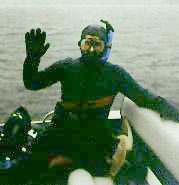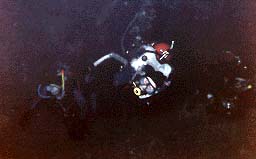My Cold Water Diving Adventures
Talk about chilling diving experiences!
[Frames Version] This page Best Viewed with the Browser of your Choice!

 |
| "Average Visibility" |
 |
| Mr. Scuba and wet suit |
How cold was it? Would you believe it was so cold that even the fishes' lips were blue? Well seriously, what is one person's cold water dive is probably someone else's cold water dive too. For all the non-diver types, the temperature of a "cold water dive" can be anywhere between 35¡ and 68¡ F.
I do all my cold water diving wearing a wet suit. That's right, boys and girls, the man said wet suit. "Why doesn't he wear a dry suit?"?, you may ask. Well, when Mr. Scuba started his diving career in 1974, "professional" divers used dry suits. The technology, as it existed at the time, was very basic and very dangerous. When you started messing with all that complicated gear and extra air lines, you were beyond "sport diving" in scope. 'Course way back then, submersible pressure gauges were looked upon with skepticism (the darn things blew up! Or should that be "out"!). BCD's were not in standard usage, nor were alternate air sources. Heck, if you wanted to go up, you swam up; if you wanted to go down, you swam down.
Yes, like the song says " . . .times change and so do I". The technology has vastly improved with time, but as I said on Mr. Scuba's Home Page, I dive less and less in cold water now, and can't seem to justify the cost of a "dry" suit. I figure that for what I would spend on a complete outfit, I could spend a week in the Caribbean, or at least fly to the far Pacific.
 |
| "Good Visibility" |
The suit I use is about eight years old and I love it; it is a U.S. Divers "Hot Bod". I guess that now everyone is calling it a "semi-dry wetsuit". (That sounds like an oxymoron to me!) The suit has latex cuffs at the neck, wrists, and ankles. The hood has a latex lining. The water seems to stay put, and if I pour a half-gallon of hot water into the suit before I dive, I stay warm enough for a 30- to 40-minute dive.
 |
| Bonne Terre Mine |
That brings to mind one big difference between warm and cold water diving: I have noticed that all my cold water dives tend to be much shorter than my warm water ones. Hmmm. Also, visibility is vastly different between my cold freshwater dives and warm saltwater dives. Great visibility to a cold water diver (say, 30 feet) is comparatively poor visibility to a warm water diver who's ideal is around 100 feet. In fact, I would venture to say that a diver with cold freshwater dive time has, in a way, already experienced the equivalent of a warm water "night" dive. The pictures on this page are illustrations of cold water diving. Some are from freshwater lakes in Michigan's Upper Peninsula, and WisconsinÊ some are from Bonne Terre MineÊin Missouri.Ê The background for this page was photographed August 3, 1996, on the tug Steven M Selvick, the newest wreck in the Alger underwater preserve. This Great Lakes tug was built in 1912, and as part of its long historic career worked on the Mackinac Bridge. Dive clubs from around the Midwest contributed to the preparation for this hulk to be sunk in Munising Michigan on May 30, 1996. The Selvick was cleaned, painted and had hatchways secured open, making it a safe dive. It is hard to create good pictures of wrecks that are often only visible in three-foot sections!
 |
| "Coming through the Keyhole" BTM |
Are there any positive aspects to cold water diving, you may ask? Yes; one of them is the fact that objects submersed in cold freshwater do not dissolve the way objects in saltwater do. I have dove wrecks that were sunk over 100 years ago, and they look as though they sank last month! One schooner still had much of its rigging intact - including deck lines and mooring lines. Automobiles also look amazingly new. However, once the materials are removed from the water, they do undergo oxidation at a tremendous rate. Unfortunately, many of the Great Lakes' more dive-accessible wrecks, of the sail period, were "salvaged" by the use of dynamite or the more expedient method of fastening a tug onto the masts and pulling them off the boat. Some of the hulks sunk in 90 feet of water had their masts sticking several feet out of the water, a hazard to navigation that had to be removed (it was not unusual for masts to be over 110 feet in height from the deck). Also, winter storms and ice can do a lot of damage to a hulk left in less than 30 feet of water.
Many frontier logging camps, tourist resorts, and communities disposed of their garbage by dragging it out onto the winter ice. This is a veritable treasure trove for the antique glass/bottle collector; even metal utensils used in cutting ice (to store in icehouses for summer refrigeration) have been retrieved by my dive buddies and me. So there is much to attract the divers with hardy constitutions, or historical interest, and I know several "technical divers" who have hundreds of hours on various wrecks, or in search of antiques discarded in the cold freshwater lakes and rivers of the Midwest.
More Cold water diving
All diving images © Neal Skrenes 1996, 1997. Please do not use without permission.
Technical notes: See the notes on Mr.Scuba's Other Interests page.
 Links to Dive Related sites on the Web
Links to Dive Related sites on the Web